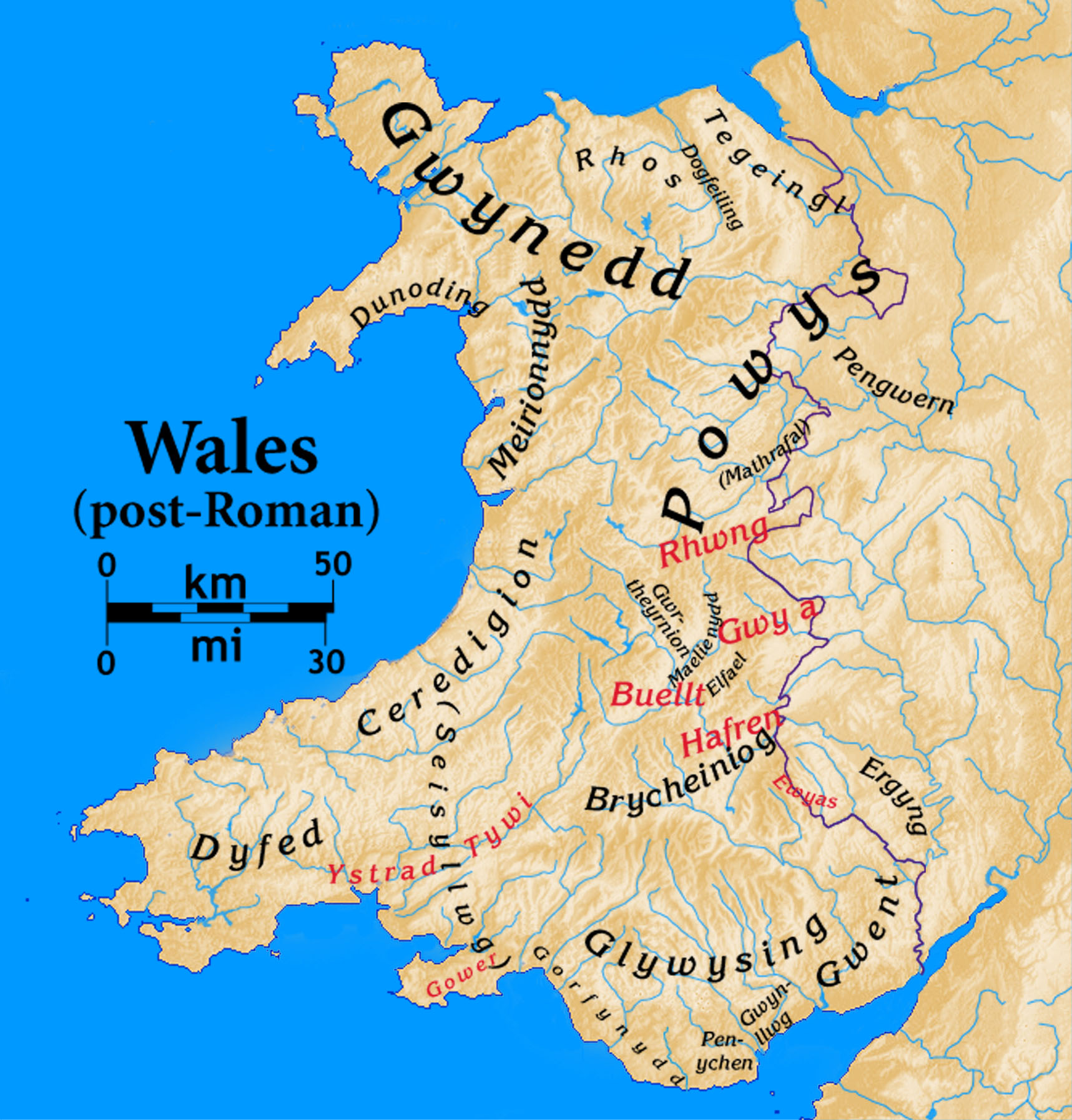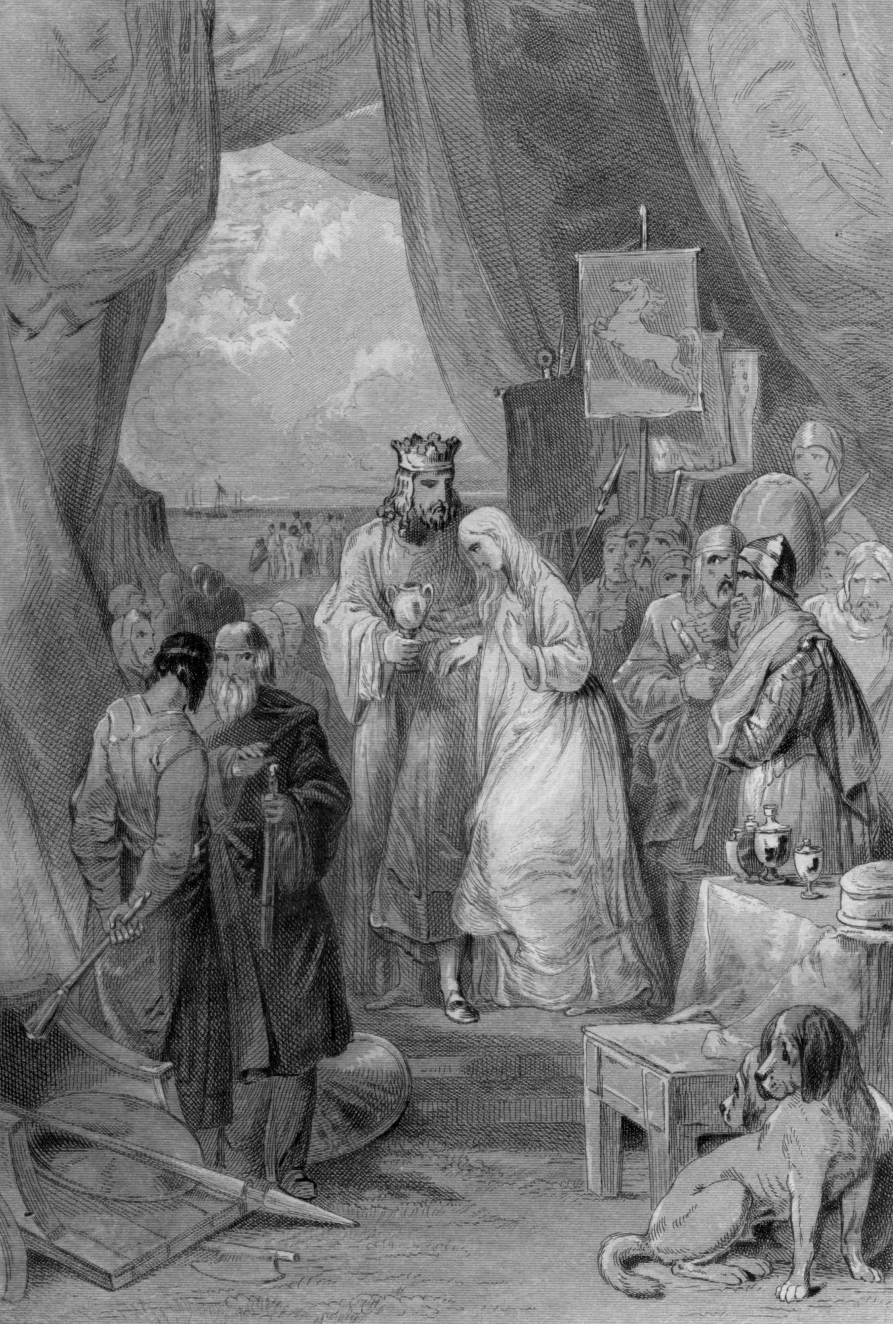|
Gruffydd Ap Cyngen
Gruffydd ap Cyngen (died ) was a prince of Powys in Wales of the Early Middle Ages. His father Cyngen ap Cadell was the last king of Powys from the old Cadelling dynasty descended from Vortigern. Gruffydd died before the realm was lost to the family of Rhodri the Great Rhodri ap Merfyn ( 820 – 873/877/878), popularly known as Rhodri the Great ( cy, Rhodri Mawr), succeeded his father, Merfyn Frych, as King of Gwynedd in 844. Rhodri annexed Powys c. 856 and Seisyllwg c. 871. He is called "King of the Britons" ..., however. He is recorded in the Welsh histories as having been treacherously slain by his brother Elisedd. References Welsh royalty 9th-century deaths Year of birth unknown {{wales-bio-stub ... [...More Info...] [...Related Items...] OR: [Wikipedia] [Google] [Baidu] |
Kingdom Of Powys
The Kingdom of Powys ( cy, Teyrnas Powys; la, Regnum Poysiae) was a Welsh successor state, petty kingdom and principality that emerged during the Middle Ages following the end of Roman rule in Britain. It very roughly covered the northern two-thirds of the modern county of Powys and part of today's English West Midlands (see map). More precisely, and based on the Romano-British tribal lands of the Ordovices in the west and the Cornovii in the east, its boundaries originally extended from the Cambrian Mountains in the west to include the modern West Midlands region of England in the east. The fertile river valleys of the Severn and Tern are found here, and this region is referred to in later Welsh literature as "the Paradise of Powys" (an epithet retained in Welsh for the modern UK county). Name The name Powys is thought to derive from Latin ''pagus'' 'the countryside' and ''pagenses'' 'dwellers in the countryside', also the origins of French "pays" and English "peasant". ... [...More Info...] [...Related Items...] OR: [Wikipedia] [Google] [Baidu] |
Wales Of The Early Middle Ages
Wales in the early Middle Ages covers the time between the Roman departure from Wales c. 383 until the end of the 10th century. In that time there was a gradual consolidation of power into increasingly hierarchical kingdoms. The end of the early Middle Ages was the time that the Welsh language transitioned from the Primitive Welsh spoken throughout the era into Old Welsh, and the time when the modern England–Wales border would take its near-final form, a line broadly followed by Offa's Dyke, a late eighth-century earthwork. Successful unification into something recognisable as a Welsh state would come in the next era under the descendants of Merfyn Frych. Wales was rural throughout the era, characterised by small settlements called ''trefi''. The local landscape was controlled by a local aristocracy and ruled by a warrior aristocrat. Control was exerted over a piece of land and, by extension, over the people who lived on that land. Many of the people were tenant peasants or s ... [...More Info...] [...Related Items...] OR: [Wikipedia] [Google] [Baidu] |
Cyngen Ap Cadell
Cyngen ap Cadell (English: Cyngen son of Cadell) or also (Concenn), was King of Powys from 808 until his death in 854 during a pilgrimage to Rome. Biography Cyngen was of the line of Brochwel Ysgithrog, and, after a long reign as king of Powys, he went on a pilgrimage to Rome and died there in 854. He is thought to be the first Welsh ruler to visit Rome after the healing of the breach between the Welsh branch of the Celtic Church and Rome over the date of Easter. Cyngen raised a pillar, originally a round-shafted cross, in memory of his great-grandfather Elisedd ap Gwylog which stands near the later abbey of Valle Crucis. This memorial had a lengthy inscription and is known as the Pillar of Eliseg owing to a typographical mistake by the original carver. Cyngen was the last of the original line of kings of Powys. He had three sons, but on his death Powys was annexed by Rhodri Mawr, ruler of Gwynedd. Certain later manuscript pedigrees (like Jesus College 20) claim that Rhodri was ... [...More Info...] [...Related Items...] OR: [Wikipedia] [Google] [Baidu] |
King Of Powys
Prior to the Conquest of Wales, completed in 1282, Wales consisted of a number of independent kingdoms, the most important being Gwynedd, Powys, Deheubarth (originally Ceredigion, Seisyllwg and Dyfed) and Morgannwg (Glywysing and Gwent). Boundary changes and the equal division of patrimony meant that few princes ever came close to ruling the whole of Wales. The names of those known to have ruled over one or more of the kingdoms are listed below. The only person known to have ruled all of Wales was Gruffydd ap Llywelyn (c. 1010–1063), a prince of Gwynedd who became King of Wales from 1055 to 1063. However, the princes of the medieval period hailing largely from west Wales, mainly Gwynedd, had such significant authority that allowed them to claim authority beyond the borders of their kingdoms. This allowed many Princes to claim to rule all Wales. Rhodri Mawr has been suggested by some as the first sovereign of Wales, and the first to unite most of Wales. The modern-day territory ... [...More Info...] [...Related Items...] OR: [Wikipedia] [Google] [Baidu] |
Cadelling
Before the Conquest of Wales, completed in 1282, Wales consisted of a number of independent kingdoms, the most important being Gwynedd, Powys, Deheubarth (originally Ceredigion, Seisyllwg and Dyfed) and Morgannwg ( Glywysing and Gwent). Boundary changes and the custom of dividing patrimonies between heirs meant that few princes ever came close to ruling the whole of Wales. The names of those known to have ruled over one or more of the kingdoms are listed below. The only person known to have ruled all of Wales was Gruffydd ap Llywelyn (c. 1010–1063), a prince of Gwynedd who became King of Wales from 1055 to 1063. Deheubarth The kingdom of Deheubarth was formed by the union of the kingdoms of Ceredigion (also known as Seisyllwg) and Dyfed by Hywel Dda in 910. Ceredigion * Ceredig ap CuneddaEncyclopaedia of Wales *Arthen ap Seisyll (?-807) *Gwgon ap Meurig (?-872) Kingdom conquered by Rhodri Mawr of Gwynedd *Rhodri Mawr (872-878) *Cadell ap Rhodri (878-910) * Hywel ... [...More Info...] [...Related Items...] OR: [Wikipedia] [Google] [Baidu] |
Vortigern
Vortigern (; owl, Guorthigirn, ; cy, Gwrtheyrn; ang, Wyrtgeorn; Old Breton: ''Gurdiern'', ''Gurthiern''; gle, Foirtchern; la, Vortigernus, , , etc.), also spelled Vortiger, Vortigan, Voertigern and Vortigen, was a 5th-century warlord in Britain, known perhaps as a king of the Britons or at least connoted as such in the writings of Bede and Gildas. His existence is contested by scholars and information about him is obscure. He may have been the "superbus tyrannus" said to have invited Hengist and Horsa to aid him in fighting the Picts and the Scots, whereupon they revolted, killing his son in the process and forming the Kingdom of Kent. It is said that he took refuge in North Wales, and that his grave was in Dyfed or the Llŷn Peninsula. Gildas later denigrated Vortigern for his misjudgement and also blamed him for the loss of Britain. He is cited at the beginning of the genealogy of the early Kings of Powys. Medieval accounts Gildas The 6th-century cleric and historia ... [...More Info...] [...Related Items...] OR: [Wikipedia] [Google] [Baidu] |
Rhodri The Great
Rhodri ap Merfyn ( 820 – 873/877/878), popularly known as Rhodri the Great ( cy, Rhodri Mawr), succeeded his father, Merfyn Frych, as King of Gwynedd in 844. Rhodri annexed Powys c. 856 and Seisyllwg c. 871. He is called "King of the Britons" by the ''Annals of Ulster.'' In some later histories, he is referred to as "King of Wales", although the title is anachronistic and his realm did not include southern Wales. Lineage and inheritance Rhodri was the son of King Merfyn Frych, who had claimed Gwynedd upon the extinction of Cunedda's male line. Rhodri then inherited the realm after his father's death around 844. Merfyn hailed from "Manaw" which may either refer to the Isle of Man or Manau, the ancestral homeland of all Gwynedd's kings since Cunedda. According to later genealogies, his mother or grandmother was Nest ferch Cadell of the ruling dynasty in Powys, and Rhodri inherited the kingdom through his uncle Cyngen and then the rule of the southern realms on the death of G ... [...More Info...] [...Related Items...] OR: [Wikipedia] [Google] [Baidu] |
Elisedd Ap Cyngen
Elisedd ap Cyngen ap Cadell Biography He was a son of Cyngen ap Cadell the last King of Powys of the Gwertherion ( Vortigern) Dynasty who claimed descent through Brochwel Ysgithrog. Cyngen died in Rome in 855 having fled the aggression of Gwynedd. His sister Nest ferch Cadell then married Merfyn (Frych) Ap Gwriadone (or possibly Mefyn's father Gwriad ab Elidir, depending on which genealogy one gives authority to) and they became the parents of Rhodri Mawr, ruler of Gwynedd, who then unified Wales under his rule. Lewys Dwnn in his visitation to Wales reports "Cadell ap Brochwell had but one daughter named Nest, who carried off the Province from the males, as appeareth, etc" (vol. i, p319). In order to explain the persistence of a male line claiming descent from the princes of Powys when the princely line ends with Cyngen, some authorities claim that he had no sons, and present the genealogy that Elisedd ap Cyngen, Aeddan ap Cyngen and Gryffydd ap Cyngen were not children of thi ... [...More Info...] [...Related Items...] OR: [Wikipedia] [Google] [Baidu] |
Welsh Royalty
Welsh may refer to: Related to Wales * Welsh, referring or related to Wales * Welsh language, a Brittonic Celtic language spoken in Wales * Welsh people People * Welsh (surname) * Sometimes used as a synonym for the ancient Britons (Celtic people) Animals * Welsh (pig) Places * Welsh Basin, a basin during the Cambrian, Ordovician and Silurian geological periods * Welsh, Louisiana, a town in the United States * Welsh, Ohio, an unincorporated community in the United States See also * Welch (other) * * * Cambrian The Cambrian Period ( ; sometimes symbolized C with bar, Ꞓ) was the first geological period of the Paleozoic Era, and of the Phanerozoic Eon. The Cambrian lasted 53.4 million years from the end of the preceding Ediacaran Period 538.8 million ... + Cymru {{Disambiguation Language and nationality disambiguation pages ... [...More Info...] [...Related Items...] OR: [Wikipedia] [Google] [Baidu] |
9th-century Deaths
The 9th century was a period from 801 ( DCCCI) through 900 ( CM) in accordance with the Julian calendar. The Carolingian Renaissance and the Viking raids occurred within this period. In the Middle East, the House of Wisdom was founded in Abbasid Baghdad, attracting many scholars to the city. The field of algebra was founded by the Muslim polymath al-Khwarizmi. The most famous Islamic Scholar Ahmad ibn Hanbal was tortured and imprisoned by Abbasid official Ahmad ibn Abi Du'ad during the reign of Abbasid caliph al-Mu'tasim and caliph al-Wathiq. In Southeast Asia, the height of the Mataram Kingdom happened in this century, while Burma would see the establishment of the major kingdom of Pagan. Tang China started the century with the effective rule under Emperor Xianzong and ended the century with the Huang Chao rebellions. While the Maya experienced widespread political collapse in the central Maya region, resulting in internecine warfare, the abandonment of cities, and a northward ... [...More Info...] [...Related Items...] OR: [Wikipedia] [Google] [Baidu] |



